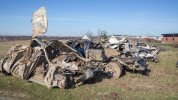Wow, I haven’t seen some if these. Very violent looking. Another overlooked area in Mayfield that received particularly impressive damage was the First Presbyterian Church. This was a true reinforced masonry building with very thick sturdy walls, and it was just completely obliterated. Extra long anchor bolts were pulled and bent, smaller bolts were snapped, and steel columns were violently ripped from their anchor plates.The Candle Factory vehicle damage is some of the worst I've seen from a tornado after Moore 2013 but it's not really brought up when talking about Mayfield and the damage, and I think it's definitely an area of EF5 intensity
It's not even just a pick and choose area either, every single vehicle in the parking lot of the factory was totaled and a lot of them were messed up pretty bad bodily wise.
People talk about Bremen, and Cambridge Shores, and the UK Grain Research Lab when it comes to Mayfield rating debates, and in each case, there’s not enough to push it solidly into the EF5 range criteria wise. But if there is one building along the path that I think deserves a deep, detailed post-analysis and review, it’s this one. As far as I know, it’s never been discussed by surveyors OR engineers in a detailed manor. I overall agree with the rating of the Mayfield tornado, but this church is the one lingering question mark in my opinion and I think it deserves a second look.
(Note: the one potential limiting factor I can see is that there does appear to be some corrosion issues, especially on the anchor plates.)






Last edited:




























